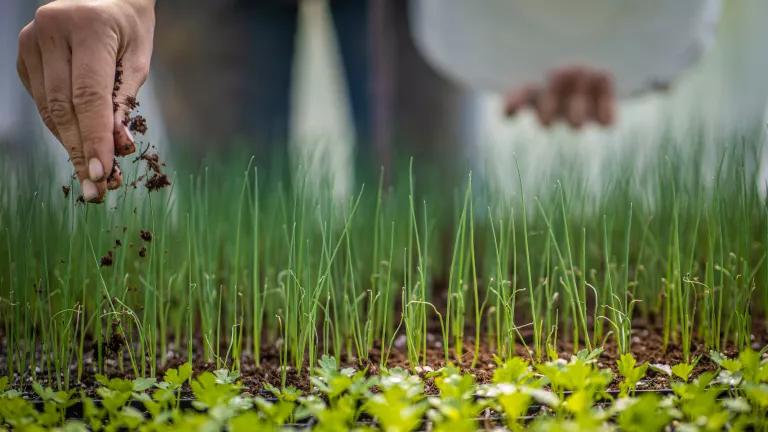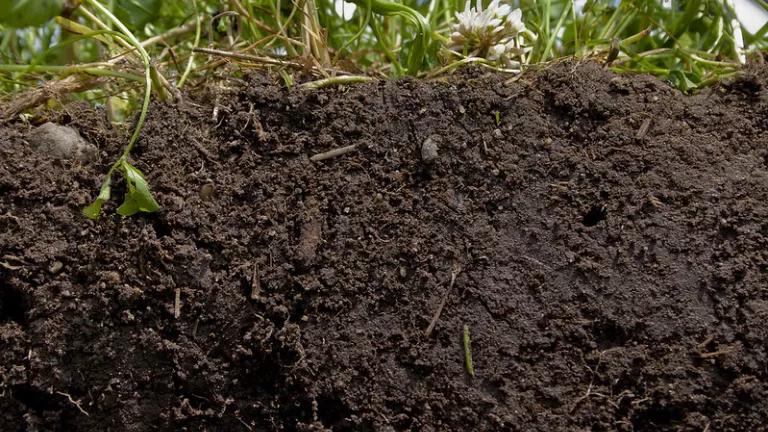NRDC Report: Pathways to Regenerative Agriculture
Regenerative agriculture is achievable—and needs support throughout the food system to reach its full potential.

Curtis Naseyowma tends to corn crops in Lower Moenkopi Village, Arizona, on the Hopi Reservation, September 20, 2021. The Hopi tribe has survived for more than a thousand years in the arid mesas. The megadrought gripping the Southwest is testing that resilience.
Tomás Karmelo Amaya/the New York Times/via Redux
Regenerative agriculture is achievable—and needs support throughout the food system to reach its full potential.
Our food and farming system is facing a reckoning—a global pandemic that upended supply chains and unearthed the horrific consequences of a consolidated meatpacking industry, climate change threatening food production across the country, fertilizer shortages, rising prices at the grocery store, and a sector that accounts for 10 percent of the United State’s greenhouse gas emissions (GHG). Our current agricultural system is failing us. It’s high time we build toward a stronger, healthier, more equitable, and more resilient one. NRDC’s report Regenerative Agriculture: Farm Policy for the 21st Century details an alternative vision of what agriculture can be—one that can respond better to external shocks (like a pandemic), combat climate change by embracing Indigenous growing principles, protect biodiversity by managing farms and ranches as ecosystems, and support competition while putting decision-making power back into the hands of independent farmers and ranchers.
NRDC interviewed more than 100 farmers and ranchers from 47 states and Washington, D.C., to learn more about regenerative agriculture and the barriers to and opportunities for practicing it on more acres. The team used qualitative analysis software to analyze interviews for themes and developed policy solutions to address the themes that emerged. Overwhelmingly, interviewees shared the ways federal agricultural policy disproportionately serves industrial agriculture over regenerative agriculture. Presented in two parts, the report first summarizes what we learned from our interviewees about the philosophy of regenerative agriculture and its principles, practices, and benefits. The second part dives into policy recommendations and shares how different parts of the food system can support more regenerative stewardship.
At its core, regenerative agriculture is a land management philosophy rooted in Indigenous wisdom, where farmers and ranchers grow in harmony with nature and their communities.
Regenerative agriculture’s principles and practices equip farmers and ranchers with the tools they need to build soil health, sequester carbon, increase biodiversity, reduce emissions, steward the land, manage natural resources, protect public health, and grow nutritious food. The growers we spoke with paid close attention to their soil, communities, and climate, and they made management decisions based on those contexts. Instead of growing water-thirsty crops in a desert, for example, regenerative growers in Arizona and New Mexico plant crops that can be dry-farmed (e.g., pumpkins and beans) because of the region’s drier climates and water scarcity. Unlike industrial agriculture, the regenerative framework encourages growers to build resilience into their farming and ranching systems, which also helps them better weather the impacts of climate change.
In February 2022, the Intergovernmental Panel on Climate Change (IPCC) released its Sixth Assessment Report, which, in part, details the far-reaching consequences of climate change. According to the report, climate change’s impacts on agriculture will vary: from more frequent extreme weather events to less water for irrigation to changing temperatures that affect crop growth. Farmers and ranchers will be required to adapt to new growing conditions. The IPCC report also acknowledges that it’s possible to buffer against these drastic changes by embracing farming systems that are regenerative.
Regenerative agriculture emphasizes building soil health, which helps fight climate change while providing a myriad of other environmental, public health, and economic benefits.
Regenerative agriculture’s focus on improving soil health provides a direct contrast to today’s dominant industrial model. Industrial agricultural practices like tillage, monocropping, fallowing, and the heavy use of chemical- and fossil fuel–produced fertilizers destroy soil and lead to erosion. Carbon is naturally stored in soil, so damaging the soil and losing it to erosion prevents agricultural lands from sequestering carbon and fighting climate. Many of regenerative agriculture’s principles and practices focus on building soil health, which restores and protects that carbon sink, and it is one way regenerative growers help fight climate change. The National Academy of Sciences estimates that soils can sequester 250 million metric tons of carbon—equivalent to the annual emissions of 64 coal-fired power plants. Regenerative growers are helping to realize that potential.

Organic farmer Michael Deakin checks for nodules that fix nitrogen on the roots of a pea cover crop, part of a diverse rotation designed to help minimize tillage and improve soil health on the farm.
Our interviewees were clear that building soil health resulted in a myriad of other benefits. By improving their soil, growers also noticed healthier plants and animals, more soil microbial activity and above-ground biodiversity, and more water stored on their land for future plant growth. They also noticed they were saving money in the long term—money they were able to reinvest into their business and land. For example, by planting cover crops, applying compost, and integrating animals back into cropping systems, regenerative growers were able to provide nutrients to the soil without applying synthetic fertilizer. These practices further protect surrounding communities from exposure to toxic chemicals and drinking water supplies from contamination.
Regenerative agriculture is achievable—and needs support throughout the food system to reach its full potential.
Each of our interviewees is a bright light—an example of how the United States can change course and transition agriculture into a solution to fight our climate crisis. But they can’t do it alone. The larger food system needs reforming so we can enable more regenerative management and support existing regenerative growers.

Farmer Liset Garcia (right) helps a customer pick out watermelons at her Sweet Girl Farms stand on July 1, 2021, in Reedley, California.
The report’s policy recommendations cover how different parts of the system can help get more acres under regenerative management and more growers practicing regeneratively.
- We need federal policy to incentivize regenerative stewardship, and that starts with reforms to the Federal Crop Insurance program, which currently spends billions subsidizing industrial agriculture.
- We need to build more agricultural infrastructure so that regenerative growers can access markets and offer consumers—individuals, businesses, and governments—the chance to purchase regeneratively grown food, fiber, and other products.
- With an aging farming population, we must cultivate the next generation of farmers and ranchers and empower them to be examples of success in their communities. Black, Indigenous, and other growers of color have historically known how to farm regeneratively, and it will be important to uphold, support (including financially), and learn from them to spur the regenerative movement.
- We must fund more regenerative agriculture research and extension services so that growers wanting to experiment with making the transition to regenerative agriculture have the support they need.
This report’s policy recommendations are only the beginning of what’s needed to transition to regenerative agriculture. The farmers and ranchers we interviewed made it very clear that every person has a role to play in advocating for a regenerative vision. From visiting a farm or a ranch and getting to know the people who grow your food and fiber to asking your local supermarket to buy from local farmers to calling elected leaders and advocating for policy changes, we can all champion regenerative agriculture and make it the norm.




